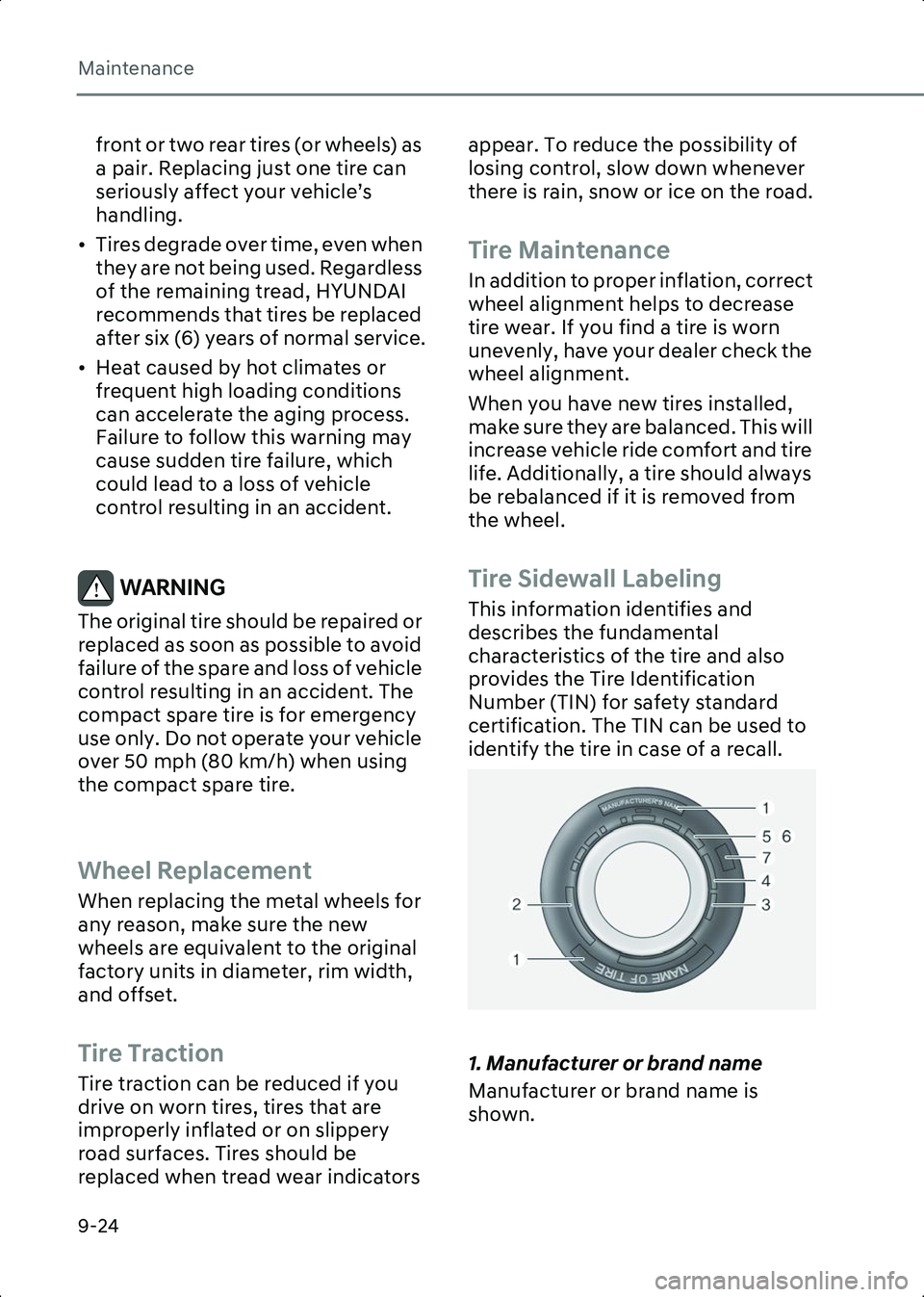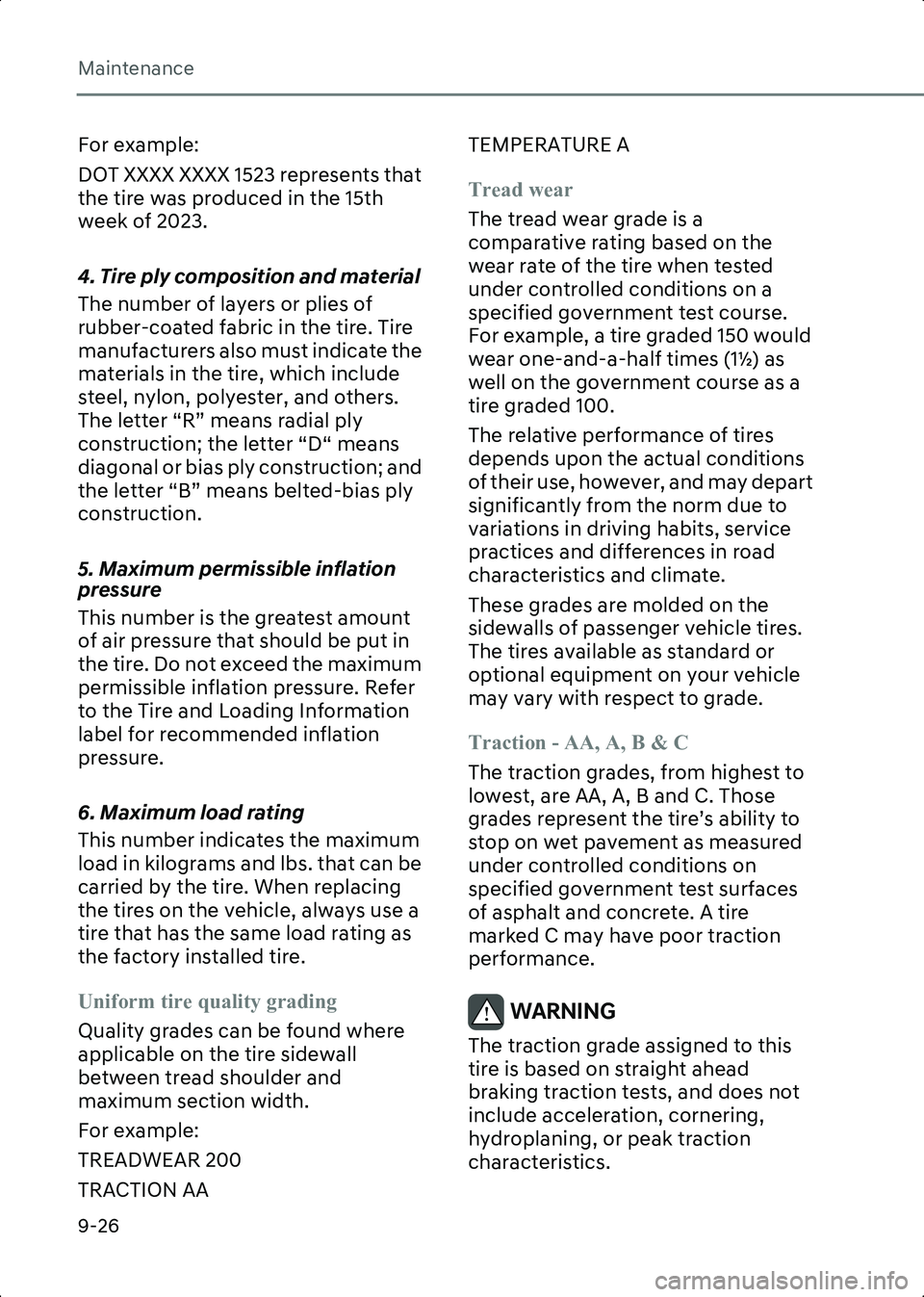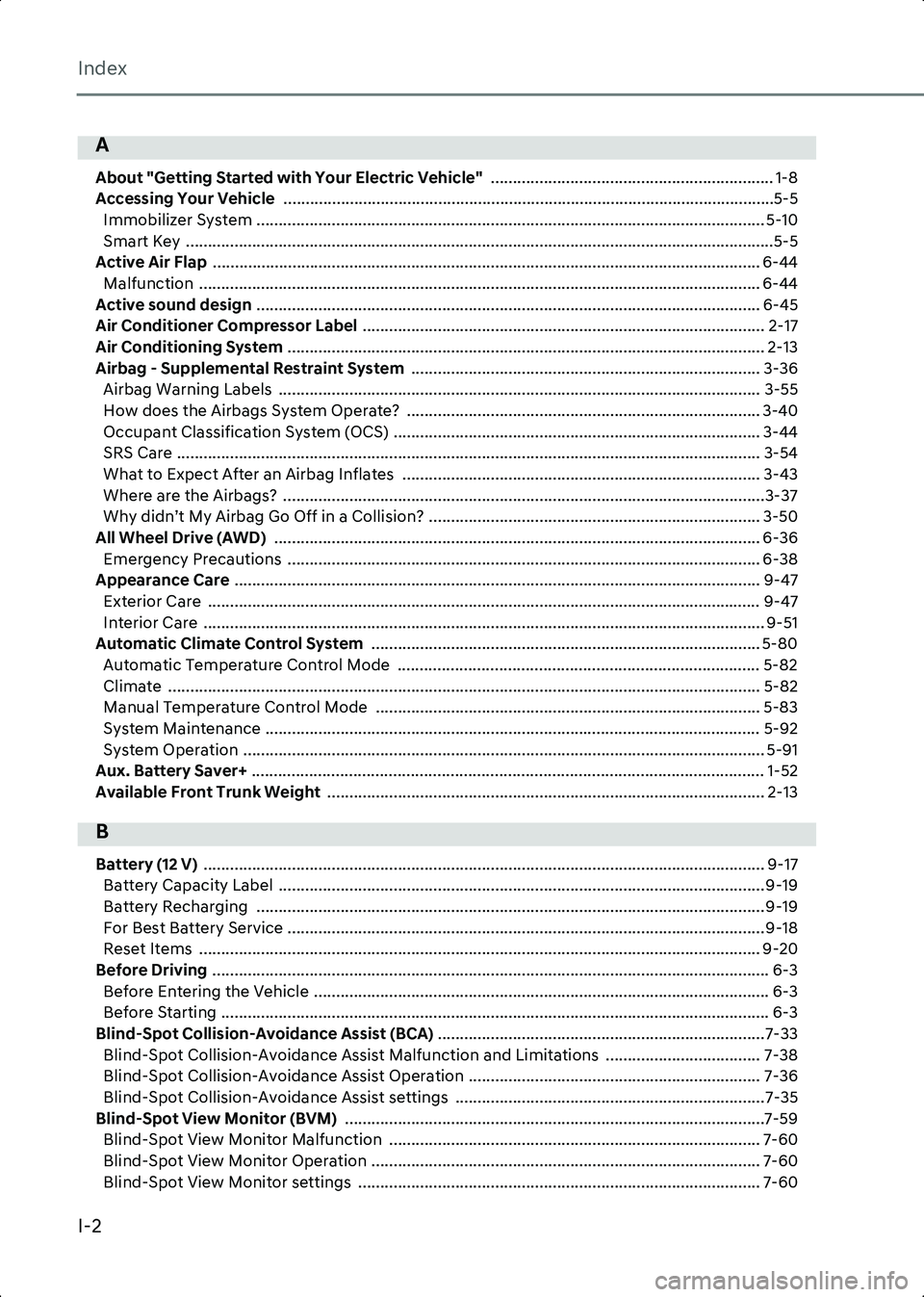2023 HYUNDAI IONIQ 6 climate control
[x] Cancel search: climate controlPage 536 of 582

Maintenance
9-20
Information
An inappropriately disposed battery can be
harmful to the environment and human health.
Dispose of the battery according to your local
law(s) or regulation.
Reset Items
The following items may need to be reset
after the battery has been discharged or
the battery has been disconnected:
• Drive info/After Recharging/Accumulated info (items in
View modes) (refer to chapter 4)
• Integrated Memory System (refer to chapter 5)
• Power Windows (refer to chapter 5)
• Wide Sunroof (if equipped) (refer to chapter 5)
• Power Trunk (refer to chapter 5)
• Automatic Climate Control System (refer to chapter 5)
• Clock (refer to the Infotainment system manual)
• Infotainment System (refer to the Infotainment system manual)
Tires and Wheels
WARNING Tire failure may cause loss of vehicle
control resulting in an accident. To
reduce risk of SERIOUS INJURY or
DEATH, take the following
precautions:
• Inspect your tires monthly for proper inflation as well as wear and
damage.
• The recommended cold tire pressure for your vehicle can be
found in this manual and on the tire
label located on the driver’s side
center pillar. Always use a tire
pressure gauge to measure tire
pressure. Tires with too much or
too little pressure wear unevenly
causing poor handling.
• Check the pressure of the spare every time you check the pressure
of the other tires on your vehicle.
• Replace tires that are worn, show uneven wear, or are damaged.
Worn tires can cause loss of braking
effectiveness, steering control, or
traction.
• ALWAYS replace tires with the same size, type, construction and
tread pattern as each tire that was
originally supplied with this vehicle.
Using tires and wheels other than
the recommended sizes could
cause unusual handling
characteristics, poor vehicle
control, or negatively affect your
vehicle’s Anti-Lock Brake System
(ABS) resulting in a serious
accident.
Hyundai_CE_en_US.book Page 20
Page 540 of 582

Maintenance
9-24
front or two rear tires (or wheels) as
a pair. Replacing just one tire can
seriously affect your vehicle’s
handling.
• Tires degrade over time, even when they are not being used. Regardless
of the remaining tread, HYUNDAI
recommends that tires be replaced
after six (6) years of normal service.
• Heat caused by hot climates or frequent high loading conditions
can accelerate the aging process.
Failure to follow this warning may
cause sudden tire failure, which
could lead to a loss of vehicle
control resulting in an accident.
WARNING The original tire should be repaired or
replaced as soon as possible to avoid
failure of the spare and loss of vehicle
control resulting in an accident. The
compact spare tire is for emergency
use only. Do not operate your vehicle
over 50 mph (80 km/h) when using
the compact spare tire.
Wheel Replacement
When replacing the metal wheels for
any reason, make sure the new
wheels are equivalent to the original
factory units in diameter, rim width,
and offset.
Tire Traction
Tire traction can be reduced if you
drive on worn tires, tires that are
improperly inflated or on slippery
road surfaces. Tires should be
replaced when tread wear indicators appear. To reduce the possibility of
losing control, slow down whenever
there is rain, snow or ice on the road.
Tire Maintenance
In addition to proper inflation, correct
wheel alignment helps to decrease
tire wear. If you find a tire is worn
unevenly, have your dealer check the
wheel alignment.
When you have new tires installed,
make sure they are balanced. This will
increase vehicle ride comfort and tire
life. Additionally, a tire should always
be rebalanced if it is removed from
the wheel.
Tire Sidewall Labeling
This information identifies and
describes the fundamental
characteristics of the tire and also
provides the Tire Identification
Number (TIN) for safety standard
certification. The TIN can be used to
identify the tire in case of a recall.
B9005401
1. Manufacturer or brand name
Manufacturer or brand name is
shown.
Hyundai_CE_en_US.book Page 24
Page 542 of 582

Maintenance
9-26
For example:
DOT XXXX XXXX 1523 represents that
the tire was produced in the 15th
week of 2023.
4. Tire ply composition and material
The number of layers or plies of
rubber-coated fabric in the tire. Tire
manufacturers also must indicate the
materials in the tire, which include
steel, nylon, polyester, and others.
The letter “R” means radial ply
construction; the letter “D“ means
diagonal or bias ply construction; and
the letter “B” means belted-bias ply
construction.
5. Maximum permissible inflation
pressure
This number is the greatest amount
of air pressure that should be put in
the tire. Do not exceed the maximum
permissible inflation pressure. Refer
to the Tire and Loading Information
label for recommended inflation
pressure.
6. Maximum load rating
This number indicates the maximum
load in kilograms and lbs. that can be
carried by the tire. When replacing
the tires on the vehicle, always use a
tire that has the same load rating as
the factory installed tire.
Uniform tire quality grading
Quality grades can be found where
applicable on the tire sidewall
between tread shoulder and
maximum section width.
For example:
TREADWEAR 200
TRACTION AATEMPERATURE A
Tread wear
The tread wear grade is a
comparative rating based on the
wear rate of the tire when tested
under controlled conditions on a
specified government test course.
For example, a tire graded 150 would
wear one-and-a-half times (1½) as
well on the government course as a
tire graded 100.
The relative performance of tires
depends upon the actual conditions
of their use, however, and may depart
significantly from the norm due to
variations in driving habits, service
practices and differences in road
characteristics and climate.
These grades are molded on the
sidewalls of passenger vehicle tires.
The tires available as standard or
optional equipment on your vehicle
may vary with respect to grade.
Traction - AA, A, B & C
The traction grades, from highest to
lowest, are AA, A, B and C. Those
grades represent the tire’s ability to
stop on wet pavement as measured
under controlled conditions on
specified government test surfaces
of asphalt and concrete. A tire
marked C may have poor traction
performance.
WARNING The traction grade assigned to this
tire is based on straight ahead
braking traction tests, and does not
include acceleration, cornering,
hydroplaning, or peak traction
characteristics.
Hyundai_CE_en_US.book Page 26
Page 572 of 582

Index
I-2
A
About "Getting Started with Your Electric Vehicle" ................................................................ 1-8
Accessing Your Vehicle ...............................................................................................................5-5
Immobilizer System ................................................................................................................... 5-10
Smart Key .....................................................................................................................................5-5
Active Air Flap ............................................................................................................................ 6-44
Malfunction ............................................................................................................................... 6-44
Active sound design .................................................................................................................. 6-45
Air Conditioner Compressor Label ........................................................................................... 2-17
Air Conditioning System ............................................................................................................ 2-13
Airbag - Supplemental Restraint System ............................................................................... 3-36
Airbag Warning Labels ............................................................................................................. 3-55
How does the Airbags System Operate? ................................................................................ 3-40
Occupant Classification System (OCS) ................................................................................... 3-44
SRS Care .................................................................................................................................... 3-54
What to Expect After an Airbag Inflates ................................................................................. 3-43
Where are the Airbags? .............................................................................................................3-37
Why didn’t My Airbag Go Off in a Collision? ........................................................................... 3-50
All Wheel Drive (AWD) .............................................................................................................. 6-36
Emergency Precautions ........................................................................................................... 6-38
Appearance Care ....................................................................................................................... 9-47
Exterior Care ............................................................................................................................. 9-47
Interior Care ............................................................................................................................... 9-51
Automatic Climate Control System ........................................................................................ 5-80
Automatic Temperature Control Mode .................................................................................. 5-82
Climate ...................................................................................................................................... 5-82
Manual Temperature Control Mode ....................................................................................... 5-83
System Maintenance ................................................................................................................ 5-92
System Operation ...................................................................................................................... 5-91
Aux. Battery Saver+ .................................................................................................................... 1-52
Available Front Trunk Weight ................................................................................................... 2-13
B
Battery (12 V) ............................................................................................................................... 9-17
Battery Capacity Label .............................................................................................................. 9-19
Battery Recharging ...................................................................................................................9-19
For Best Battery Service ............................................................................................................9-18
Reset Items ............................................................................................................................... 9-20
Before Driving .............................................................................................................................. 6-3
Before Entering the Vehicle ....................................................................................................... 6-3
Before Starting ............................................................................................................................ 6-3
Blind-Spot Collision-Avoidance Assist (BCA) ..........................................................................7-33
Blind-Spot Collision-Avoidance Assist Malfunction and Limitations ................................... 7-38
Blind-Spot Collision-Avoidance Assist Operation .................................................................. 7-36
Blind-Spot Collision-Avoidance Assist settings ......................................................................7-35
Blind-Spot View Monitor (BVM) ...............................................................................................7-59
Blind-Spot View Monitor Malfunction .................................................................................... 7-60
Blind-Spot View Monitor Operation ........................................................................................ 7-60
Blind-Spot View Monitor settings ........................................................................................... 7-60
Hyundai_CE_en_US.book Page 2
Page 573 of 582

I
I-3
Brake Fluid .................................................................................................................................. 9-13
Checking the Brake Fluid Level ................................................................................................ 9-13
Braking System .......................................................................................................................... 6-22
Anti-Lock Brake System (ABS) ................................................................................................. 6-30
Auto Hold .................................................................................................................................. 6-27
Brake Assistant System (BAS) .................................................................................................. 6-34
Brake Disc Cleaning .................................................................................................................. 6-29
Disc Brakes Wear Indicator ...................................................................................................... 6-23
Electronic Parking Brake (EPB) ................................................................................................ 6-24
Electronic Stability Control (ESC) ............................................................................................. 6-31
Good Braking Practices ............................................................................................................ 6-35
Hill-Start Assist Control (HAC) ................................................................................................. 6-34
Power-Assist Brakes ................................................................................................................. 6-22
Vehicle Stability Management (VSM) ..................................................................................... 6-33
Bulb Wattage ............................................................................................................................... 2-11
C
Cabin Air Filter ............................................................................................................................9-14
Filter Inspection .........................................................................................................................9-14
Filter Replacement ....................................................................................................................9-14
California Perchlorate Notice .................................................................................................. 9-53
Center Console Overview ........................................................................................................... 2-5
Charging Your Electric Vehicle ..................................................................................................1-12
Checking Basic Information on Charging Your Electric Vehicle .............................................1-15
Safety Precautions for Charging Your Electric Vehicle ............................................................1-12
Using a DC Charger ................................................................................................................... 1-24
Using a Portable Charger (ICCB) .............................................................................................. 1-26
Using an AC Charger .................................................................................................................. 1-21
Child Restraint System (CRS) ................................................................................................... 3-28
Children Always in the Rear ..................................................................................................... 3-28
Installing a Child Restraint System (CRS) ............................................................................... 3-30
Selecting a Child Restraint System (CRS) ............................................................................... 3-29
Climate Control Additional Features ...................................................................................... 5-96
A/C Automatic Drying .............................................................................................................. 5-96
Auto Defogging System ........................................................................................................... 5-96
Auto Dehumidify ....................................................................................................................... 5-97
Automatic Controls Linked to Climate Control Settings (for driver’s seat) .......................... 5-99
Recirculating Air When Washer Fluid Is Used ........................................................................ 5-98
Recirculation Mode Plus .......................................................................................................... 5-98
Smart Ventilation ...................................................................................................................... 5-99
Sunroof Inside Air Recirculation .............................................................................................. 5-98
Cluster Display ........................................................................................................................... 4-23
Cluster Display Control ............................................................................................................ 4-23
View Modes ............................................................................................................................... 4-23
Consumer Information .............................................................................................................. 2-18
Convenience Features ................................................................................................................. 5-1
Coolant ........................................................................................................................................ 9-12
Changing Coolant ...................................................................................................................... 9-13
Countermeasures for Accidents or Fire ................................................................................... 1-65 If the Electric Vehicle Catches Fire ...........................................................................................1-66
Hyundai_CE_en_US.book Page 3